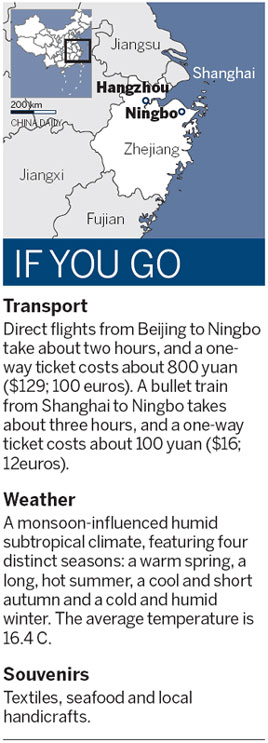The perfect balance
Updated: 2013-02-01 07:55
(China Daily)
|
||||||||
|
Dongqian Lake is the largest natural freshwater lake in East China's Zhejiang province. Provided to China Daily |
Despite rapid development, Ningbo has retained its peaceful soul
With a history of more than 7,000 years as well as rapid development, Ningbo enjoys the best of both worlds. It manages to balance both traditional and progressive, peaceful and lively, with an array of surprising but pleasant contrasts along the way.
Located on the shore of the East China Sea and on the south side of the Yangtze River Delta, the city is well known for some of China's most impressive Buddhist temples and attractive scenery.
Close Shanghai, it is also an important economic center and base for the chemical industry.
A stroll through Ningbo's streets reveals the city's peaceful soul despite rapid modernization. It is a city trying hard to remain livable and beautiful, without holding back development to do so.
Ningbo's main attractions are its beautiful landscape and cultural heritage, much of it with strong Buddhist connections.
Here are some of the main sights:
1. Tianyi Pavilion Library

Built in 1561, Tianyi Pavilion is the oldest existing private library in China. Housing more than 300,000 books, it is often referred to as the Book City of South China.
With a corridor extending from the front to the back and a pond for putting out fires, the space is typical of a southern private garden on the lower reaches of the Yangtze River.
When it was being rebuilt in 1933, the Zunjing Pavilion of Ningbo's Confucian Temple was moved into the garden, adding to its charm.
2. Baoguo Temple
On the side of Lingshan Mountain, 15 kilometers from downtown, Baoguo Temple is a well-known cultural and scenic spot.
First established in the Eastern Han Dynasty (AD 25-220) and rebuilt and expanded in later dynasties, the present Baoguo Temple exhibits the wisdom of antique architecture. It is the oldest entirely wooden structure in China, and is held together without a single nail.
Unusually, no birds or insects make their home in the temple roof. A team working on restoring the building in 1975 found out that pungent smell that the wood gives off keeps them away.
3. Asoka Temple
Situated at the southern foot of Mount Pushan, 20 kilometers from Ningbo, Asoka Temple is renowned for its ancient buildings, gardens and exquisite architectural style.
Named after Asoka, a king of India, the temple is home to a bone fragment of Sakyamuni, Buddhism's founder.
Covering an area of 24,000 square meters, the temple is a favorite tourist spot for Buddhists from China and abroad.
Symmetrical in its layout, it contains more than 600 halls, floors and pavilions containing some exquisite sculptures and paintings, including the Four Heavenly Guardians and the Sixteen Princes.
The temple also contains numerous historical relics including calligraphy or couplets written by Chinese emperors and ancient artifacts.
4. Dongqian Lake
Just 15 kilometers southeast of Ningbo, Dongqian Lake is renowned for its picturesque mountains, clean water and rich cultural heritage.
As the largest natural freshwater lake in Zhejiang province, it covers an area of 22 square kilometers, four times that of Hangzhou's West Lake.
The history of the lake, which is split into three parts - Guzi Lake, North Lake, and South Lake - stretches back 1,200 years.
Eating
As an important component of Zhejiang Cuisine, Ningbo's food is well-known for its softness and flavor. Given Ningbo's location, fish is a favorite and it can be found on every menu.
Bingtang jiayu (steamed turtle in crystal sugar soup), which is bright gold, is one of the city's best-known dishes.
Rice glue balls, made with fine glutinous rice powder and pork wrapped by lotus leaves are also popular.
China Daily
(China Daily 02/01/2013 page22)

 Li Na on Time cover, makes influential 100 list
Li Na on Time cover, makes influential 100 list
 FBI releases photos of 2 Boston bombings suspects
FBI releases photos of 2 Boston bombings suspects
 World's wackiest hairstyles
World's wackiest hairstyles
 Sandstorms strike Northwest China
Sandstorms strike Northwest China
 Never-seen photos of Madonna on display
Never-seen photos of Madonna on display
 H7N9 outbreak linked to waterfowl migration
H7N9 outbreak linked to waterfowl migration
 Dozens feared dead in Texas plant blast
Dozens feared dead in Texas plant blast
 Venezuelan court rules out manual votes counting
Venezuelan court rules out manual votes counting
Most Viewed
Editor's Picks

|

|

|

|

|

|
Today's Top News
Boston bombing suspect reported cornered on boat
7.0-magnitude quake hits Sichuan
Cross-talk artist helps to spread the word
'Green' awareness levels drop in Beijing
Palace Museum spruces up
First couple on Time's list of most influential
H7N9 flu transmission studied
Trading channels 'need to broaden'
US Weekly

|

|









